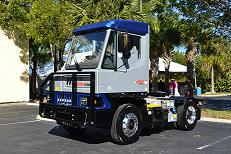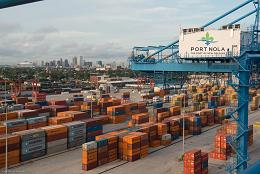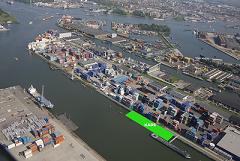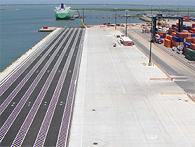According to year-end totals, 490,526 TEU (twenty-foot-equivalent units) moved through the Port’s Napoleon Avenue Container Terminal during the 12 months – an 8.8 percent increase over the 2013 total of 451,057.
“Strong export markets, primarily for chemical and agriculture products, together with new inbound customers such as Chiquita contributed to record container volumes,” said Port President and CEO Gary LaGrange. “New services in 2015, such as the recently announced CMA CGM weekly European service, and a full year of Chiquita cargo could translate into robust results again in 2015.”
The Port welcomed a new weekly European service from French container carrier CMA CGM Feb. 2 with the arrival of the CMA CGM Jamaica. In addition, Chiquita Brands International, along with their sailing partner Mediterranean Shipping Company, began weekly service to the Port in October, after relocating its shipping operations to New Orleans after a 40-year hiatus.
New Orleans Terminal and Ports America jointly operate the container terminal – with New Orleans Terminal handling the new Chiquita cargo and Ports America handling the CMA CGM service. The new services join existing customers MSC, Hapag-Lloyd, Maersk, Seaboard Marine, CSAV, Zim, NYK, Orient Overseas Container Line, American President Line, Hyundai and MOL offering regular container services at the terminal. In an effort to attract new container services, the Port’s Board of Commissioners recently approved a new incentive dockage rate for a new service’s first 20 vessel calls.
“It takes a collaborative effort of the entire maritime community to achieve success, compete globally and sustain that competitive advantage,” LaGrange said. “We will continue to be proactive in meeting our customers’ needs.”
Efforts to expand the container terminal are well underway. The new Mississippi River Intermodal Terminal is taking shape within the terminal, which will result in a modern and efficient intermodal container transfer terminal to facilitate the movement of marine and rail cargo, while enhancing safety and reducing the carbon footprint of the regional and national transportation systems. The total investment for the 12-acre project is $25.1 million, which includes a $16.7 million federal Transportation Investment Generating Economic Recovery (TIGER) grant. The intermodal terminal will add an estimated 200,000 TEUs of capacity to the Napoleon Avenue Container Terminal – bringing total capacity to 840,000 TEUs per year. Expected completion date is February of 2016.
In addition, the Port and New Orleans Terminal are jointly investing $7.9 million in a refrigerated container racking system within the container terminal to store more than 600 refrigerated containers at once, due to the surging demand for refrigerated cargo in New Orleans – primarily imported bananas and exported poultry. The installation is scheduled for completion by year’s end.
The Port of New Orleans is a deep-draft multipurpose port at the center of the world’s busiest port system — Louisiana’s Lower Mississippi River. Connected to major inland markets and Canada via 14,500 miles of waterways, six class-1 railroads and the interstate highway system, the Port is the ideal gateway for steel, project cargo, containers, coffee, natural rubber, chemicals, forest products, manufactured goods and cruising. An extensive network of ocean carrier services, along with added-value services like transloading of bulk into containers, make the Port of New Orleans the superior logistics solution for many types of cargo. To stay ahead of market demand, the Port has invested over $100 million in capital improvement projects since 2012 and has a Master Plan to expand the Napoleon Avenue Container Terminal to an annual capacity of 1.6 million TEU.





